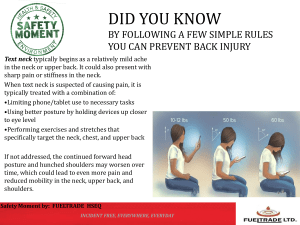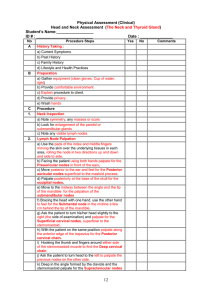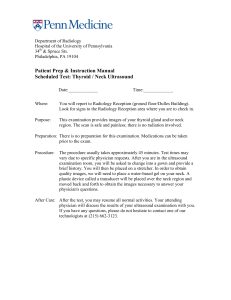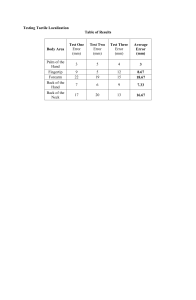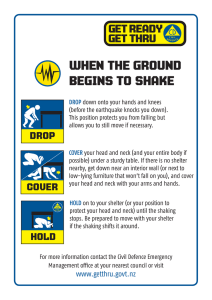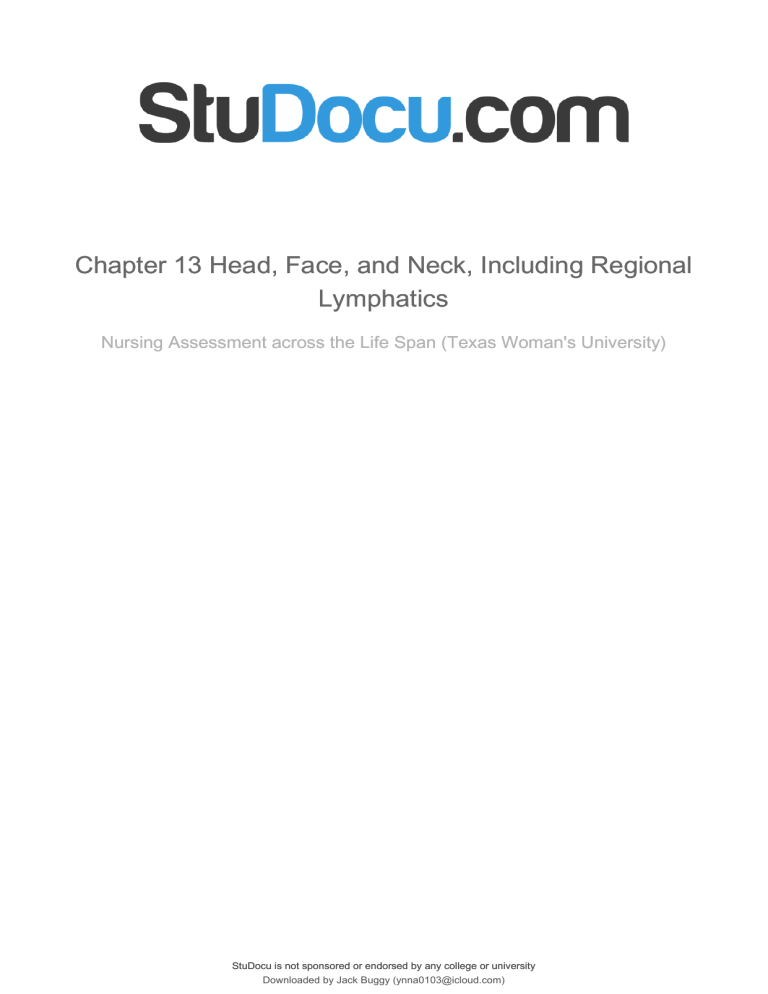
lOMoARcPSD|11068438 Chapter 13 Head, Face, and Neck, Including Regional Lymphatics Nursing Assessment across the Life Span (Texas Woman's University) StuDocu is not sponsored or endorsed by any college or university Downloaded by Jack Buggy (ynna0103@icloud.com) lOMoARcPSD|11068438 Chapter 13: Head, Face, and Neck, Including Regional Lymphatics The Head ★ Skull - rigid bony box that protects the brain and special sense organs ★ Cranial bones: ○ Frontal ○ Parietal ○ Occipital ○ Temporal ★ Cranial sutures ○ Coronal suture - crowns the head from ear to ear at the union of frontal and parietal bones ○ Sagittal suture - separates the head lengthwise between parietal bones ○ Lambdoid suture - separates the parietal bones crosswise from the occipital bone ★ Facial bones ○ Nasal bone ○ Zygomatic bone ○ Maxilla ○ Mandible ★ Cranium is supported by the cervical vertebrae: C1 (axis), C2 (atlas) through C7 (vertebra prominens) ★ The face: ○ Facial muscles mediated by cranial nerve VII ○ Facial muscle function is symmetric bilaterally ○ Facial structures are symmetrical: eyebrows, eyes, ears, nose, mouth, palpebral fissures, nasolabial folds ○ Facial sensations of touch are mediated by cranial nerve V (trigeminal nerve) ○ Salivary glands: ■ Parotid glands - in the cheeks over the mandible; largest salivary glands but not normally palpable ■ Submandibular glands - beneath the mandible at the angle of the jaw ■ Sublingual glands - lie in the floor of the mouth ○ Temporal artery - superior to the temporalis muscle and its pulsation is palpable anterior to the ear ★ The Aging Adult ○ Facial bones and orbits appear more prominent ○ Facial skin sags The Neck ★ Major neck muscles ○ Sternomastoid - arises from the sternum and clavicle and extends diagonally to Downloaded by Jack Buggy (ynna0103@icloud.com) lOMoARcPSD|11068438 ★ ★ ★ ★ ★ the mastoid process behind the ear; it accomplishes head rotation and flexion ○ Trapezius - arise from occipital bone and vertebrae, extend to the scapula and clavicle; move the shoulders and extend and turn the head Landmarks ○ Anterior triangle - lies in front between the sternomastoid and midline of the body, with its base up along the lower border of the mandible and its apex at the suprasternal notch ○ Posterior triangle - behind the sternomastoid muscle, with the trapezius muscle on the other side and its base along the clavicle Thyroid Gland ○ Straddles the trachea in the middle of the neck ○ Synthesizes and secretes thyroxine and triiodothyronine that stimulate rate of cellular metabolism ○ Two lobes that curve posteriorly between trachea and sternomastoid muscle and connect in the middle (isthmus). Cricoid cartilage ○ Just above the thyroid isthmus - upper tracheal ring Thyroid cartilage ○ Above the cricoid cartilage with a small palpable notch in its upper edge ○ “Adam’s apple” in males Hyoid bone ○ Palpated high in the neck at the level of the floor of the mouth Lymphatics ★ Head and neck have 60 to 70 lymph nodes ○ Preauricular - in front of the ear ○ Posterior auricular - superficial to the mastoid process ○ Occipital - at the base of the skull ○ Submental - midline, behind the tip of the mandible ○ Submandibular - halfway between the angle and the tip of the mandible ○ Jugulodigastric (tonsillar) - under the angle of the mandible ○ Superficial cervical - overlying the sternomastoid muscle ○ Deep cervical - deep under the sternomastoid muscle ○ Posterior cervical - in the posterior triangle along the edge of the trapezius muscle ○ Supraclavicular - just above and behind the clavicle at the sternomastoid muscle ★ Drainage patterns ○ When nodes are enlarged, check the area they drain. ○ All drain down expect for supraclavicular, which drains up Subjective Data Downloaded by Jack Buggy (ynna0103@icloud.com) lOMoARcPSD|11068438 ★ Headache ○ An unusually frequent or unusually severe headaches? ○ OLDCARTS ○ Ever had this kind of headache before? ○ Do you have any other illnesses? ○ Do you take any medications? ○ Any family history of headaches? ○ Tension headaches: ■ occipital or frontal with bandlike tightness ■ Viselike ■ Associated with anxiety and stress ○ Migraines: ■ Vascular ■ tend to be supraorbital, retroorbital, or frontotemporal ■ throbbing, severe pain ■ occur twice per month, each lasting 1 to 3 days ■ alcohol, stress, menstruation, chocolate, cheese precipitate ■ associated with N/V and visual disturbances ■ Family history ■ People lie down to feel better ○ Cluster headaches: ■ produce pain around the eye, temple, forehead, cheek ■ unilateral on same side of head ■ excruciating pain ■ occur once or twice per day, each lasting ½ to 2 hours ■ alcohol and daytime napping precipitate ■ Associated with eye reddening and tearing, eyelid drooping, rhinorrhea and nasal congestion ■ People need to move to feel better ○ Hypertension, fever, hypothyroidism, vasculitis, oral contraceptives, bronchodilators, alcohol, nitrates, and carbon monoxide inhalation can cause headaches ○ How have these headaches affected your self-care or ability to function? ★ Head injury ○ Any head injury or blow to your head? ○ OLDCARTS ○ Are symptoms worse, better, or unchanged since injury? ○ Loss of consciousness before a fall may have a cardiac cause ○ A change in LOC is most important in evaluating a neurologic deficit ★ Dizziness ○ Experienced any dizziness? Downloaded by Jack Buggy (ynna0103@icloud.com) lOMoARcPSD|11068438 ★ ★ ★ ★ ○ Describe it for me ○ Presyncope: a light-headed, swimming sensation or feeling of fainting or falling caused by decreased blood flow to the brain or heart irregularity causing decreased cardiac output. ○ Vertigo: true rotational spinning often from labyrinthine-vestibular disorder in inner ear ■ Objective vertigo: the person feels like the room is spinning ■ Subjective vertigo: the person feels like he or she is spinning ○ Disequilibrium: a shakiness or instability when walking related to musculoskeletal disorder or multi-sensory deficits Neck Pain ○ OLDCARTS ○ Acute onset of neck stiffness with headache and fever occurs with meningeal inflammation Lumps or Swelling ○ Any recent tenderness or infection? ■ Tenderness suggests acute infection ■ Persistent lump arouses suspicion of malignancy ○ Any history of irradiation of head, neck, upper chest? ■ Increased risk for salivary and thyroid tumors ○ Any difficult swallowing? ■ Dysphagia ○ Smoking history ■ Smoking and chewing tobacco increases risk for oral and respiratory cancer ○ Alcohol history ■ Increases risk for cancer when combined with smoking ○ Thyroid problems? History of head or neck surgery ○ Ever had surgery of the head or neck? ■ Can cause disfigurement and increases risk for body image disturbance ○ For what condition? ○ When was the surgery? ○ How do you feel about the results? The Aging Adult ○ Patient-centered care: how does condition affect ADL’s and IADL’s? ■ Assess potential for injury Objective Data The Head Downloaded by Jack Buggy (ynna0103@icloud.com) lOMoARcPSD|11068438 ★ Inspect and Palpate the Skull ○ Size and shape ■ Normocephalic - a round symmetric skull that is appropriately related to body size ■ Microcephalic - abnormally small head ■ Hydrocephalic/Acromegaly - abnormally large head ■ Place fingers in person’s hair and palpate scalp. No tenderness to palpation ■ Note lumps, depressions, or abnormal protrusions ○ Temporal area ■ Palpate the temporal artery above the zygomatic bone between the eye and the top of the ear ● Note if the artery looks tortuous, feels hardened, or is tender ■ The temporomandibular joint is just below the temporal artery ● Palpate as the person opens the mouth ● Observe smooth movement with no limitation or tenderness ● Abnormal: crepitation, limited ROM, tenderness ★ Inspect the Face ○ Facial structures ■ Note facial expression and appropriateness to behavior or reported mood ● Anxiety is common in hospitalized or ill person ○ Tense, rigid muscles ● Note hostility or aggression ● Flat affect may indicate depression ■ Features should always be symmetric - eyebrows, palpebral fissures, nasolabial folds, sides of mouth ● Marked asymmetry with central brain lesion (stroke), cranial nerve VII damage (Bell palsy) ■ Note any abnormal facial structures ● Coarse features, exophthalmos, changes in skin color/pigmentation ■ Note abnormal swelling ● Edema occurs first around the eyes and cheeks (where subQ tissue is loose) ■ Note involuntary movements ● Tics, grinding of jaws, fasciculations, excessive blinking The Neck ★ Inspect and Palpate the Neck ○ Symmetry ■ Head position is centered in midline ■ Accessory neck muscles should be symmetric ■ Head should be erect and still ■ Head tilt occurs with muscle spasm Downloaded by Jack Buggy (ynna0103@icloud.com) lOMoARcPSD|11068438 ■ Rigid head and neck occur with arthritis ○ Range of Motion ■ Note any limitation or pain of movement ■ Ask person to perform ROM ● Motion should be smooth and controlled ● Ratchety or limited movement could be from cervical arthritis or inflammation of neck muscles ■ Cranial nerve XI ● Try to resist person from shrugging shoulders and turning head from side to side ■ Note enlargement of salivary or lymph glands ● Swollen parotid gland can be seen when head is extended swelling below angle of jaw ● Thyroid enlargement may be unilateral or diffuse ● Parotid can be swollen with mumps or AIDS ■ Note any obvious pulsations (carotid) ★ Lymph Nodes ○ Use gentle circular motion of finger pads ○ Begin with preauricular nodes and move in systematic order ○ Use gentle pressure ○ Compare bilaterally ○ Note location, size, shape, delimitation, mobility, consistency, and tenderness ○ Normal nodes feel movable, discrete, soft, and nontender ○ Lymphadenopathy: enlargement of lymph nodes (> 1 cm) from infection, allergy, or neoplasm ○ If nodes are enlarged or tender, check the area they drain for the source of the problem ■ Acute infection: acute onset, < 14 days duration, nodes are bilateral, enlarged, warm, tender, and firm, but freely movable ■ Chronic inflammation: in TB the nodes are clumped ■ Cancerous nodes: hard, > 3 cm, unilateral, nontender, matted, fixed ■ HIV infection: enlarged, firm, nontender, mobile (occipital node) ■ Neoplasm in thorax or abdomen: single, enlarged, nontender, hard, left supraclavicular node ■ Hodgkin lymphoma: painless, rubbery, discrete, gradually appear, commonly in cervical region ★ Trachea ○ Normally the trachea is midline ○ Trachea is pushed to unaffected (healthy) side with aortic aneurysm, tumor, unilateral thyroid lobe enlargement, pneumothorax ○ Trachea is pulled toward affected (diseased) side with large atelectasis, pleural Downloaded by Jack Buggy (ynna0103@icloud.com) lOMoARcPSD|11068438 adhesions, or fibrosis ○ Tracheal tug - a rhythmic downward pull that is synchronous with systole and occurs with aortic arch aneurysm ★ Thyroid Gland ○ Difficult to palpate ○ Look for diffuse enlargement or a nodular lump ○ Usually you cannot palpate the normal adult thyroid ○ Sometimes feel the isthmus over the tracheal rings ○ If the thyroid is enlarged, auscultate it for the presence of a bruit (a soft, pulsatile, whooshing, blowing sound heard best with the bell) The Aging Adult ★ Temporal arteries may look twisted and prominent ★ Senile tremors - mild rhythmic tremor of the head such as nodding and tongue protrusion ★ If teeth have been lost, lower face looks abnormally small with mouth sunken in ★ Kyphosis ★ Perform ROM slowly ★ Prolapse of submandibular glands Downloaded by Jack Buggy (ynna0103@icloud.com)
